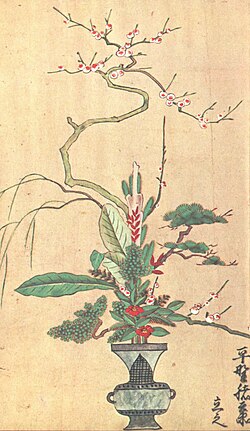立花
Appearance
Japanese
[edit]Etymology 1
[edit]
| Kanji in this term | |
|---|---|
| 立 | 花 |
| たち Grade: 1 |
はな > ばな Grade: 1 |
| kun'yomi | |
Compound of 立ち (tachi, “standing”, the 連用形 (ren'yōkei, “continuative or stem form”) of verb 立つ tatsu, “to stand”) + 花 (hana, “flower”). The hana changes to bana as an instance of rendaku (連濁).
Pronunciation
[edit]Proper noun
[edit]- a surname
- any of various place names
- a school or style of ikebana
Usage notes
[edit]The rikka reading may be more common for the ikebana school sense.
Etymology 2
[edit]
| Kanji in this term | |
|---|---|
| 立 | 花 |
| りつ > りっ Grade: 1 |
か Grade: 1 |
| on'yomi | |
/rikkwa/ → /rikka/
Possibly from Middle Chinese compound 立花 (MC lip xwae, “lit. stand + flower”) or 立華 (MC lip xwae, “lit. stand + flower”).
Alternatively, coined in Japan of Middle Chinese-derived components.
Alternative forms
[edit]Pronunciation
[edit]- (Tokyo) りっか [ríꜜkkà] (Atamadaka – [1])[1][2]
- (Tokyo) りっか [rìkká] (Heiban – [0])[1]
- IPA(key): [ɾʲik̚ka̠]
Noun
[edit]- (Buddhism) a style of floral arrangement as an offering, typically using branches of pine or plum placed upright in a copper vase
Proper noun
[edit]References
[edit]- ↑ 1.0 1.1 Matsumura, Akira, editor (2006), 大辞林 [Daijirin] (in Japanese), Third edition, Tokyo: Sanseidō, →ISBN
- ^ Kindaichi, Kyōsuke et al., editors (1997), 新明解国語辞典 [Shin Meikai Kokugo Jiten] (in Japanese), Fifth edition, Tokyo: Sanseidō, →ISBN
Categories:
- Japanese terms spelled with 立 read as たち
- Japanese terms spelled with 花 read as はな
- Japanese terms with rendaku
- Japanese terms read with kun'yomi
- Japanese compound terms
- Japanese terms with IPA pronunciation
- Japanese lemmas
- Japanese proper nouns
- Japanese terms with multiple readings
- Japanese terms spelled with first grade kanji
- Japanese terms with 2 kanji
- Japanese surnames
- Japanese terms spelled with 立 read as りつ
- Japanese terms spelled with 花 read as か
- Japanese terms read with on'yomi
- Japanese terms derived from Middle Chinese
- Japanese nouns
- Japanese terms historically spelled with わ
- ja:Buddhism
- ja:Neighborhoods in Aichi Prefecture
- ja:Places in Aichi Prefecture
- ja:Places in Japan

